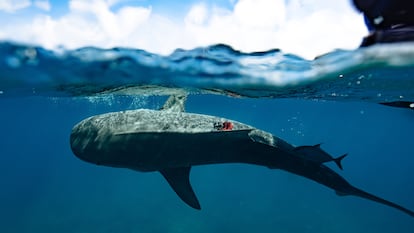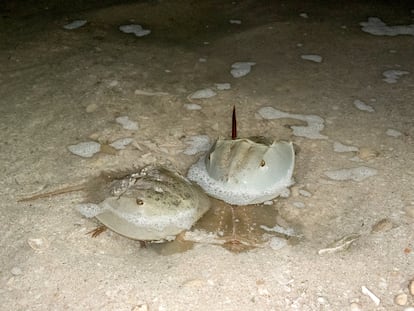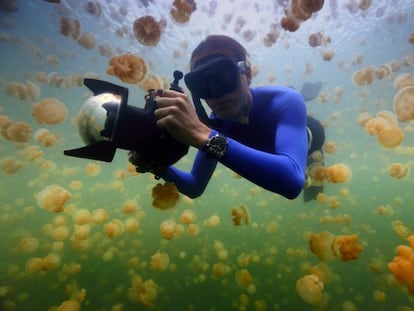Sharks with cameras, key in finding world’s largest seagrass meadow
Scientists placed devices on the marine predators, who helped map up to 92,000 square kilometers of seagrass in the Bahamas
The tiger sharks that were chosen by the scientists to carry geolocation sensors and a 360-degree camera were unaware of their mission. Still, the data they collected was crucial in the research led by Beneath the Waves, an American NGO that fights for the conservation of the oceans.
The association between scientists and sharks has made it possible to locate the largest seagrass meadow ever discovered on Earth: it is in the Bahamas and covers an area of up to 92,000 square kilometers. These meadows are essential to trap carbon (the main greenhouse gas), as habitats for marine species and to defend coastlines against erosion, storms and tsunamis. Today, the greatest threat to these meadows is posed by the anchors of the large yachts that gather in the area. The success of this method has opened the door to the possibility of using large marine animals to explore the ocean.
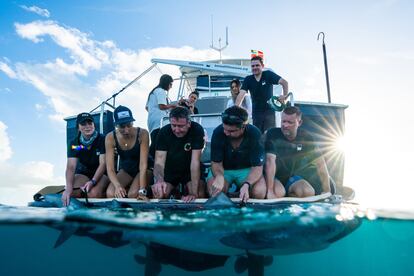
The data collected by the tiger sharks (Galeocerdo cuvier, the largest apex predator in tropical seas), validated the main cartographic data of the scientists, recently published in the scientific journal Nature Communications. Beneath the Waves has spent decades monitoring the behavior of the species, protected by the government of the Bahamas, in order to determine how the marine areas they frequent could be improved. In addition to being research partners, the creatures contribute to keeping the meadows healthy by preying on herbivorous species like sea turtles, dugongs and manatees, which could cause their decline by feeding on these grasses. While they search for green turtles – their favorite – sharks devote 72% of their time to patrolling these seabeds, swimming about 70 kilometers a day.
The scientists have taken advantage of their habits to map the immense underwater prairie. Carlos M. Duarte, professor of marine science at King Abdullah University of Science and Technology in Saudi Arabia and co-author of the article, explains that they complemented the data contributed by the sharks with material from 2,400 underwater dives and previous satellite estimates. However, the dives only covered 5% of the area, so the data provided by the sharks proved essential.
Using sharks, which can measure up to 18 feet in length and weigh more than 1250 pounds, is not an easy task. After capturing them with bait, they were immobilized; then the sensors were set up before the sharks were released.
When Austin Gallagher, lead scientist and CEO of Beneath The Waves, found that tiger sharks traversed seagrass beds, he and Duarte decided to equip them with 360-degree cameras in an attempt to monitor the entire area. In total they placed 15 devices: eight for position, temperature and other parameters, and seven cameras. The only way to recover the sensors is for them to come loose after a set period of time, as recapturing the sharks is very difficult. When the devices are released, they float and emit a location signal.
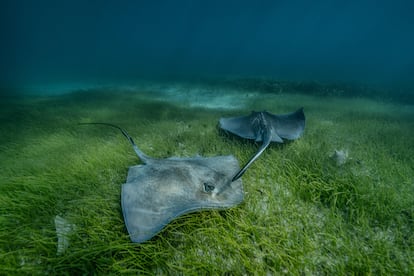
The second largest seagrass meadow ever found was located in 2009 in Australia’s Great Barrier Reef, with an area of 40,000 square kilometers. That is half the upper estimate for the one in the Bahamas, which is thought to store about 20% of all the carbon trapped in the world, Duarte estimates. In that sense, seagrass meadows fulfill the same function as the terrestrial ecosystems, but with better results, sequestering 10 times more carbon per hectare than the Amazon rainforest. Hence the importance of these plants.
The relevance of the discovery does not prevent Duarte from pondering the reasons why such an extension, being only 30 to 50 feet deep, had not been found before – a fact which, he reflects, is a clear sign of the poor knowledge that exists of the ocean. Gallagher adds that this discovery proves how everything is connected: the fact that the shark protection in the Bahamas facilitated this study, thanks to which sharks led the researchers to the seagrass ecosystem, which could be the most important blue carbon sink on the planet. If protected, these seagrass meadows can play a crucial role in slowing down the current climate emergency.
Tu suscripción se está usando en otro dispositivo
¿Quieres añadir otro usuario a tu suscripción?
Si continúas leyendo en este dispositivo, no se podrá leer en el otro.
FlechaTu suscripción se está usando en otro dispositivo y solo puedes acceder a EL PAÍS desde un dispositivo a la vez.
Si quieres compartir tu cuenta, cambia tu suscripción a la modalidad Premium, así podrás añadir otro usuario. Cada uno accederá con su propia cuenta de email, lo que os permitirá personalizar vuestra experiencia en EL PAÍS.
¿Tienes una suscripción de empresa? Accede aquí para contratar más cuentas.
En el caso de no saber quién está usando tu cuenta, te recomendamos cambiar tu contraseña aquí.
Si decides continuar compartiendo tu cuenta, este mensaje se mostrará en tu dispositivo y en el de la otra persona que está usando tu cuenta de forma indefinida, afectando a tu experiencia de lectura. Puedes consultar aquí los términos y condiciones de la suscripción digital.
More information
Archived In
Últimas noticias
Venezuela hardens its ‘revolutionary state’ project amid pressure from Trump
Sydney Sweeney, the actress praised by Trump: ‘Women are up against what society wants them to be’
The Bolsonaro surname: An advantage or liability in Brazil’s 2026 presidential elections?
Raúl Rocha, from jet-setting with Miss Universe to arms trafficking and fuel theft
Most viewed
- Reinhard Genzel, Nobel laureate in physics: ‘One-minute videos will never give you the truth’
- Pablo Escobar’s hippos: A serious environmental problem, 40 years on
- Charles Dubouloz, mountaineering star, retires at 36 with a farewell tour inspired by Walter Bonatti
- Why we lost the habit of sleeping in two segments and how that changed our sense of time
- The fall of a prolific science journal exposes the billion-dollar profits of scientific publishing
